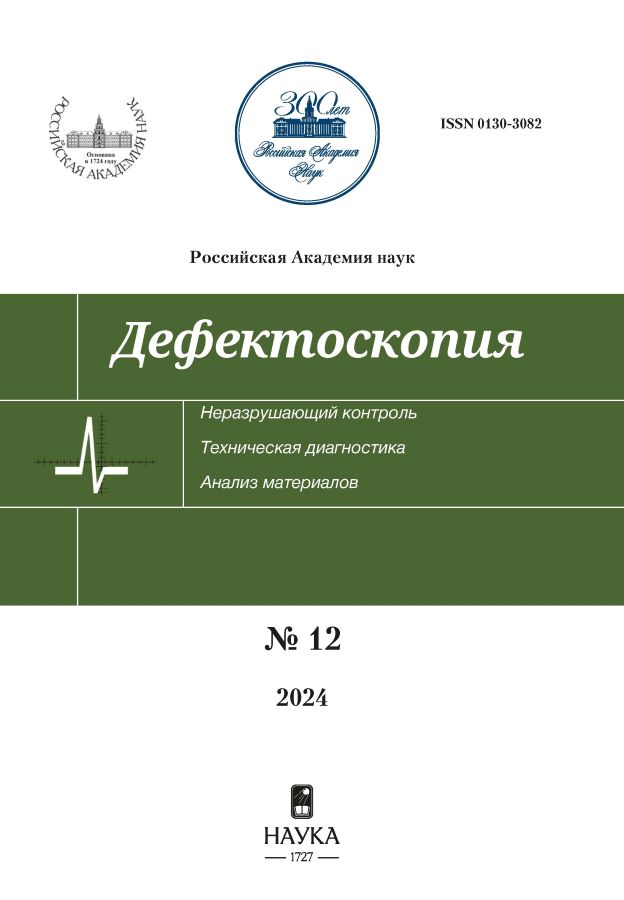Features of Planar Localization of Acoustic Emission Sources via the Inglada’s Triangulation Algorithm
- Autores: Matvienko Y.G.1, Vasiliev I.E.1, Balandin T.D.1, Chernov D.V.1
-
Afiliações:
- Blagonravov Institute of Mechanical Engineering Research of the Russian Academy of Sciences
- Edição: Nº 12 (2024)
- Páginas: 3-13
- Seção: Acoustic methods
- URL: https://archivog.com/0130-3082/article/view/649286
- DOI: https://doi.org/10.31857/S0130308224120011
- ID: 649286
Citar
Texto integral
Resumo
This paper presents a methodology for enhancing the efficiency of acoustic emission (AE) source detection during planar localization using the Inglada’s algorithm. The study analyzes the main factors affecting the accuracy of AE source localization when using a standard planar localization approach. These factors include the threshold-based method of determining the signal registration time by AE sensors, which is based on detecting the moment when the rising wavefront voltage exceeds the discrimination threshold (uth), the signal sampling frequency (fd), and the influence of the medium’s dispersion properties on the attenuation of signal amplitude and wave propagation speed. To reduce the impact of these factors on the localization accuracy of AE sources, a novel methodology is proposed based on the use of correlation dependencies of AE pulse propagation speed on the amplitude of the recorded signals, as well as on accounting for the delay in the registration time of AE pulses during threshold detection. A series of preliminary experiments was conducted to implement the proposed methodology, where AE pulses were generated using an electronic simulator with a maximum amplitude level of um = 45—90 dB. The position of the AE pulse source varied in the range of 150 to 700 mm relative to the receiving sensors of the antenna array. As a result of applying the developed methodology, the probability of AE source detection increased to p = 0,71, compared to p = 0,36 when using the standard approach.
Texto integral
Sobre autores
Yu. Matvienko
Blagonravov Institute of Mechanical Engineering Research of the Russian Academy of Sciences
Autor responsável pela correspondência
Email: chernovdv@inbox.ru
Rússia, Moscow
I. Vasiliev
Blagonravov Institute of Mechanical Engineering Research of the Russian Academy of Sciences
Email: chernovdv@inbox.ru
Rússia, Moscow
T. Balandin
Blagonravov Institute of Mechanical Engineering Research of the Russian Academy of Sciences
Email: chernovdv@inbox.ru
Rússia, Moscow
D. Chernov
Blagonravov Institute of Mechanical Engineering Research of the Russian Academy of Sciences
Email: chernovdv@inbox.ru
Rússia, Moscow
Bibliografia
- Ivanov V.I., Barat V.A. Akustiko-emissionnaya diagnostika (Acoustic-Emission Diagnostics). Moscow: Spektr, 2017.
- Bigus G.A., Daniev Yu.F., Bystrova N.A., Galkin D.I. Osnovy diagnostiki tekhnicheskikh ustroistv i sooruzhenii (Fundamentals of Diagnostics of Technical Devices and Structures). Moscow: Mosk. Gos. Tekh. Univ. im. N.E. Baumana, 2015.
- Matvienko Yu.G., Vasil’ev I.E., Chernov D.V., Ivanov V.I., Elizarov S.V. Problemy lokatsii istochnikov akusticheskoy emissii (Problems of Locating Acoustic Emission Sources) // Defectoscopiya. 2021. No. 9. P. 35—44. doi: 10.29296/defectoscopy.2021.9.35-44
- Ser’eznov A.N., Stepanova L.N., Kabanov S.I. Akustiko-emissionnyy kontrol’ defektov svarki (Acoustic-Emission Control of Welding Defects). Novosibirsk: Nauka, 2018.
- Matvienko Yu.G., Ivanov V.I., Vasil’ev I.E., Chernov D.V., Mishchenko I.V. Opredelenie skorosti rasprostraneniya volnovogo paketa v kompozitnykh materialakh (Determination of Wave Packet Propagation Velocity in Composite Materials) // Pribory i Tekhnika Eksperimenta. 2020. No. 1. P. 115—120. doi: 10.31857/S0032816220010231
- Wotzka D. Influence of Frequency and Distance on Acoustic Emission Velocity Propagating in Various Dielectrics // Applied Sciences (Switzerland). 2020. V. 10. No. 9. P. 3305. doi: 10.3390/app10093305
- Chen S., Yang C., Wang G., Liu W. Similarity assessment of acoustic emission signals and its application in source localization // Ultrasonics. 2017. V. 75. P. 36—45. doi: 10.1016/j.ultras.2016.11.005
- Marchenkov A., Zhgut D., Moskovskaya D., Kulikova E., Vasiliev I., Chernov D., Mishchenko I. Estimation of acoustic source positioning error determined by one-dimensional linear location technique // Applied Sciences (Switzerland). 2022. V. 12. No. 1. doi: 10.3390/app12010224
- Kalafat S., Sause M.G.R. Acoustic emission source localization by artificial neural networks // Structural Health Monitoring. 2015. V. 14. No. 6. P. 633—647. doi: 10.1177/1475921715607408
- Matvienko Yu.G., Vasil’ev I.E., Chernov D.V., Kozhevnikov A.V., Mishchenko I.V. Povishenie veroyatnosti viavleniya istochnikov akusticheskoy emissii s pomoshch’yu iskusstvennykh neyronnykh setey (Increasing the Probability of Detecting Acoustic Emission Sources Using Artificial Neural Networks) // Defectoscopiya. 2022. No. 5. P. 3—12. doi: 10.29296/defectoscopy.2022.5.3-12
- Grabowski K., Gawronski M., Staszewski W.J., Uhl T., Packo P. Acoustic emission localization through excitability prediction and dispersion removal technique / Progress in Acoustic Emission XVIII, JSNDI & IIIAE-23 (December 5—9, 2016). P. 217—220.
- Yang X., Zhou J., Gao C., Zhang P., Liu T., Zhang K., Zhang C. An acoustic emission source localization approach based on time-reversal technology for additive manufacturing / MATEC Web of Conferences. 2022. V. 355. No. 5. P. 01008. doi: 10.1051/matecconf/202235501008
- Al-Jumaili S.K., Pearson M.R., Holford K.M., Eaton M.J., Pullin R. Acoustic emission source location in complex structures using full automatic delta T mapping technique // Mechanical Systems and Signal Processing. 2016. V. 72—73. P. 513—524. doi: 10.1016/j.ymssp.2016.09.005
- Middleton C.A., McCrory J.P., Greene R.J., Holford K., Patterson E.A. Detecting and Monitoring Cracks in Aerospace Materials Using Post-Processing of TSA and AE Data // Metals. 2019. V. 9. No. 7. P. 748. doi: 10.3390/met9070748
- Spencer S.J. The two-dimensional source location problem for time differences of arrival at minimal element monitoring arrays // The Journal of the Acoustical Society of America. 2007. V. 121. No. 6. P. 3579—3594. doi: 10.1121/1.2717430
- Ser’eznov A.N., Stepanova L.N., Murav’ev V.V., Komarov K.L., Kabanov S.I., Lebedev E.Yu., Kojemakin V.L., Pan’kov A.F. Akustiko-emissionnaya diagnostika konstruktsiy (Acoustic-Emission Diagnostics of Structures). Moscow: Radio i Svyaz, 2000. P. 92—112.
Arquivos suplementares


















